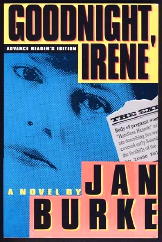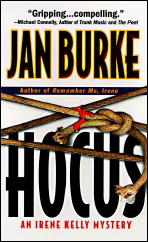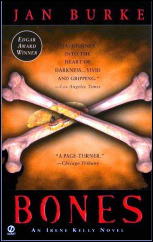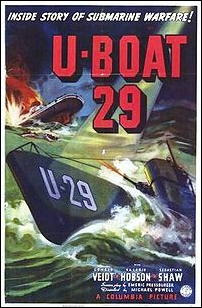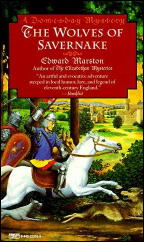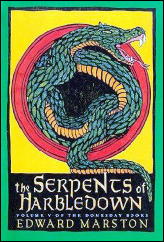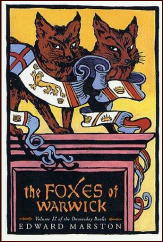July 2010
Monthly Archive
Sat 17 Jul 2010
REVIEWED BY BARRY GARDNER:
JAN BURKE – Sweet Dreams, Irene. Simon & Schuster, hardcover, March 1994. Reprint paperbacks: Avon, February 1995; Pocket, September 2002. Irene Kelly #2.
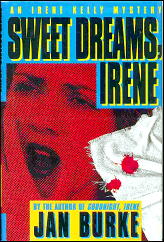
I thought Burke’s first novel, Good Night, Irene, was one of the better new voices this year, and Irene Kelly one of the better characters. The sophomore jinx seems to be a common thing with mystery novelists, though, so I kept my expectations under control.
Things are going good and bad for intrepid reporter Irene Kelly. Good is her romance with the cop from the first book, and bad is that her paper has taken her off the police beat because of the relationship.
She’s handling a race for DA as the book opens, and the son of one of the candidates comes to her for help. His father’s opponent is going to relase a picture that shows the kid as part of a Satanic cult; except it’s not, it’s a witches’ coven, and he’s not really part of it.
Irene begins to dig around, but before she gets very far, the rich, elderly neighbor of her lover is murdered, with signs pointing toward satanic worship. The murdered woman sponsored a homeless shelter where some of the “witches†lived. Could there be a connection? Could, yes.
I still like Burke’s writing. She has an easy, unforced style, and paces her story very well. As with her first book, the characters major and minor are clearly drawn and believable. The plot is complex, and in the end, I’m afraid it wasn’t very convincing. A villain was dragged in out of left field, or maybe from a neighboring ballpark.
Burke did well telling the story of Irene and her lover, but despite a lot of bloody action the criminal plot just didn’t hang together for me. Good taste, but not enough calories.
— Reprinted from Ah, Sweet Mysteries #10, November 1993.
The Irene Kelly Mysteries:
* Goodnight, Irene (1993)
* Sweet Dreams, Irene (1994)
* Dear Irene (1995)
* Remember Me, Irene (1996)
* Hocus (1997)
* Liar (1998)
* Bones (1999) [Edgar winner, Best Novel]
* Flight (2001) (from the POV of Frank Harriman)
* Bloodlines (2005)
* Kidnapped (2006)
Award Nominations —
Agatha Award Best Novel nominee (1997) : Hocus
Agatha Award Best Novel nominee (1998) : Liar
Macavity Awards Best Novel nominee (1998) : Hocus
Anthony Awards Best Novel nominee (2000) : Bones
Anthony Awards Best Novel nominee (2002) : Flight
Macavity Awards Best Novel nominee (2003) : Nine
Anthony Awards Best Novel nominee (2006) : Bloodlines
Anthony Awards Best Novel nominee (2007) : Kidnapped
Fri 16 Jul 2010
REVIEWED BY WALTER ALBERT:
WHY WORRY? Hal Roach Studios, 1923. Harold Lloyd, Jobyna Ralston, Johan Aasen, Wallace Howe, James Mason, Leo White. Directors: Fred C. Newmeyer & Sam Taylor. Shown at Cinecon 27, Hollywood CA, September 1993.

Harold Lloyd plays a “young millionaire with an absolute patent on hypochondria.” (And I thought I had that sewed up tight.)
He travels to a “sleepy” Latin American village on the eve of a revolution where — with an apparently inexhaustible supply of energy and ingenious tricks — this most engaging of silent film comedians sets about foiling the dastardly designs of villain James Mason, with the help of a gentle giant played by John Aasen.
The organ accompaniment was played by octogenarian Gaylord Carter who worked with Lloyd in the thirties, preparing musical scores for the re-release of the silent masterpieces.
Editorial Comment: I went to IMDB to be sure, but the James Mason in this movie is not THE James Mason, just in case you might be wondering about him. Usually billed as Jim Mason, the one in this film became a cowboy actor, playing mostly small parts until his career ended in the early 1950s.
The movie itself is available on DVD, in the box set The Harold Lloyd Comedy Collection, Volume 1, on sale everywhere.
Thu 15 Jul 2010
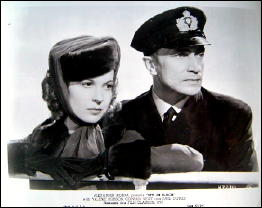
THE SPY IN BLACK. Columbia Pictures, UK, 1939. Released in the US as U-Boat 29. Conrad Veidt, Valerie Hobson, Sebastian Shaw, Marius Goring, June Duprez, Cyril Raymond. Screenplay: Emeric Pressburger, based on the novel by J. Storer Clouston. Director: Michael Powell.
What’s unusual about this wartime movie is not that it takes place in World War I, but for at least the first half of the film it’s more or less from the point of view of a German submarine captain (Conrad Veidt) who undertakes a deadly game of espionage in the Orkney Islands (all the way in the UK, off the northen tip of Scotland).

Aided by a phony schoolteacher (Valerie Hobson) and a turncoat British naval officer (Sebastian Shaw), Captain Hardt lays a deadly U-Boat trap for a large contingent of British warships. If he can pull it off, it would be a serious blow to Britain’s war making capabilities.
Things don’t go as planned, however, and that’s when the fun begins. The local vicar expects the new schoolteacher and her fiancé to come to dinner, and neither the phoney schoolteacher nor her new boarder expect the fiancé at all.
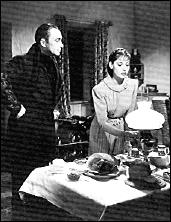
And of course that’s only the beginning. Since of course the spectacular event in the works never happened, there’s no suspense in that regard, but how it’s avoided – and who survives – is still very much up in the air.
Getting back to my first paragraph, though, it’s quite remarkable that a German officer could be portrayed as sympathetically in 1939, sort of, as Captain Hardt is in the first part of the movie – finding a good meal – with real butter! – one of the great advantages of going undercover in wartime Britain. Of course when his role requires him to become a deadly enemy, he does that too – but honorably.
I wish I could tell you what it is that makes a movie like this one so unmistakably British, but it is – a certainly style, a certain attitude – whatever it is, I think it mirrors the British people as well.
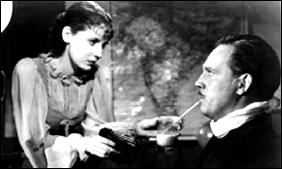
So British, I have to admit, as to make the opening scenes, taking place in Germany, somewhat awkward, if not clumsily done. The newspapers are in English, not German, and the people in the tavern speak English, not German.
Once Captain Hardt is back at sea, though, and his mission is underway, the film gets off this small artifice and the crew members speak German, or largely so.
Other than that, while not an award-winner by any means, this is still a better than average wartime thriller. It’s also one that takes place not on the battlefield or at sea, but on the home front, just in time for the next one.
Thu 15 Jul 2010
A TV Review by MIKE TOONEY:
“Death and the Joyful Woman.” An episode of The Alfred Hitchcock Hour (Season 1, Episode 27). First air date: 12 April 1963. Gilbert Roland, Laraine Day, Don Galloway, Frank Overton, Laura Devon, Tom Lowell, Richard Bull, Raymond Greenleaf. Teleplay: James Bridges, tenuously based on the novel Death and the Joyful Woman (1961) by Ellis Peters. Director: John Brahm.
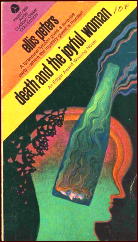
It’s going to be quite an evening at the Aguilar estate. Luis Aguilar (Gilbert Roland) plans to make an announcement at a big dinner party he’s throwing. He intends to publicly disown his son, Al (Don Galloway), because he won’t take on the family business (wine bottling); ironically enough, Al doesn’t even drink alcohol! For Luis, this is intolerable.
Before this night is over, Luis will make a pass at a young woman; Al will nearly drink himself into a coma trying to win $5,000 from Luis, money that would help pay the bills for the baby that’s on the way; someone will be murdered; another will get koshed and thrown in a giant vat to drown; and a faithful servant will see her hopes dashed and attempt suicide.
Yes, indeed, quite an evening is in store at the Aguilar estate.
Ellis Peters (real name: Edith Pargeter, 1913-95) is most famous for her series of novels featuring the medieval monk Brother Cadfael, filmed and shown on PBS as Cadfael (13 episodes, 1994-98). This Hitchcock adaptation of her novel radically alters the story, if the description of it on the Fantastic Fiction website is accurate. (See below.)
Gilbert Roland (1905-94) was a silent film star who successfully made the transition to the talkies. Laraine Day (1920-2007) was present in Hollywood’s Golden Age; her last screen credit was a two-parter on Murder, She Wrote (1986). And Don Galloway (1937-2009) is best remembered as Detective Sergeant Ed Brown in just about every episode of the Ironside TV series (1967-75).
“Death and the Joyful Woman” is available on Hulu here.
From the Fantastic Fiction website:
“One of the George Felse mysteries. Det Sgt Felse is called in to investigate a murder at a new roadhouse, once a beautiful old inn known as ‘The Joyful Woman.’ There is no shortage of suspects, but the arrest of Kitty Norris leads Felse’s young son, who is convinced she is innocent, into danger.”
Thu 15 Jul 2010
IT IS PURELY MY OPINION
Reviews by L. J. Roberts
EDWARD MARSTON – The Owls of Gloucester. St. Martin’s, US, hardcover, April 2003. Headline, UK, hardcover/softcover, 2000.
Genre: Historical mystery. Leading characters: Sir Ralph Delchard/Gervase
Bret; 10th in series. Setting: England-Middle Ages/1000s.
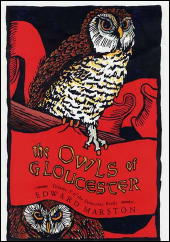
First Sentence: ‘Do you want to be beaten again?’ asked Brother Frewine quietly.
King William’s commissioner’s; Sir Ralph Delchard, accompanied by his wife Golde, lawyer Gervase Bret, Canon Hubert and Brother Simon, arrive in Gloucester to follow up on discrepancies and disputes found after the first round in the making of the Domesday Book.
The largest dispute is over land, which has four claimants. However, their visit becomes more complicated with the discovery of a murdered monk, Brother Nicholas, the Abbey’s tax collector, the disappearance of a young novice, and the impending arrival of King William himself.
There is nothing I did not like about this book. Marston places us in the 11th century both in sight and sound. By his descriptions, it is easy to visualize the surroundings. You know the conditions around them and when the characters are riding “hell-for-leather,†you can see and hear the horses.
The pattern and syntax of the dialogue provides a reflection of the period without being literal to it. The inclusion of subtle humor is always appropriate and gives balance to the action.
Marston’s characters are wonderful. Ralph, the newly married, battle-scarred soldier, is a realistic combination of an impatient Norman warrior and one who never expected to remarry after the passing many year’s prior of his beloved first wife. In this book, I particularly appreciated Ralph learning to be a husband to Golde, the realistic display of his anger and his confession to Gervase of a personal fear.
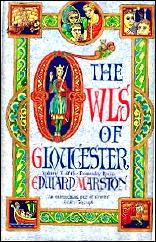
Gervase, Saxon by ancestry, is the younger, recently married, educated lawyer who thinks before acting. The two have different natures and approaches but their friendship has given them a perfect balance. With them are the egotistical Canon Hubert and the very fearful, particularly of women, young Brother Simon.
It is aspects such as that which gives dimension and realism to the characters. The plot was interesting and intricate with fascinating historical information which was interwoven with the story. There are multiple threads to the story which adds to the realism, and a very effective red herring.
What is most impressive is the way in which the various threads come together at the end in a double climax, neither villain being one I anticipated. All these elements, and the overall quality of Marston’s writing, made for an excellent read.
It is also nice that, while I always recommend reading series in order, with the Domesday series, it is not essential as each book includes enough background for each of the leading characters that the book stands on its own.
My one regret is that there are only, to date, only eleven books in this series. I’ve only read five, though, so I still have several yet to enjoy.
Rating: Excellent.
The Domesday series:
1. The Wolves of Savernake (1993)
2. The Ravens of Blackwater (1994)
3. The Dragons of Archenfield (1995)
4. The Lions of the North (1996)
5. The Serpents of Harbledown (1996)
6. The Stallions of Woodstock (1997)
7. The Hawks of Delamere (1998)
8. The Wildcats of Exeter (1998)
9. The Foxes of Warwick (1999)
10. The Owls of Gloucester (2000)
11. The Elephants of Norwich (2000)
Wed 14 Jul 2010
Posted by Steve under
Reviews[14] Comments
Reviewed by DAVID L. VINEYARD:
MARGERY ALLINGHAM – The Tiger in the Smoke. Chatto & Windus, UK, hardcover, 1952. Doubleday, US, hc, 1952. Reprinted many times in both hardcover and paperback, including (shown): Dell 777, pb, ca.1954; Avon T-530, pb, ca.1961; Bantam, pb, 1985.
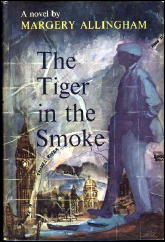
Film: As Tiger in the Smoke. J. Arthur Rank, 1956. Tony Wright, Donald Sinden, Alec Clunes, Muriel Pavlow, Bernard Miles, Laurence Naismith, Christopher Rhodes. Screenplay by Anthony Pelissier based on the novel by Margery Allingham. Director: Roy Ward Baker.
The Tiger in the Smoke is a rarity among genre novels — a book that is also a first class novel. I can only think of a handful that fill that category: Nicholas Blake’s Death and Daisy Bland and A Private Wound, Michael Innes’s The New Sonia Wayward, Raymond Chandler’s The Long Goodbye…
That Tiger in the Smoke also features Albert Campion, one of the major figures of the Golden Age of Detective fiction is all the more remarkable.
Not that Tiger is a product of the Golden Age. For much of the novel we know who the criminal is and what his motive is. The novel is far more interested in the question of good and evil than simply who dunnit.
The book wasn’t recognized as a masterpiece initially — at least not by everyone. Some critics seemed confused by Allingham stretching the boundaries of the detective story. In retrospect it has gained the reputation it deserves, though it sits outside the whole canon of Campion stories despite his presence and that of Inspector Charlie Luke, who had been introduced in More Work for the Undertaker, Amanda Campion, and the ever present Lugg.
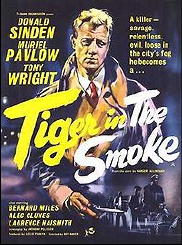
Notably the film leaves Campion, Amanda, and Lugg out of the story completely and they aren’t particularly missed.
Three characters dominate Tiger: Jack Havoc is a former commando, war hero, deserter, and wild card, a Teddy Boy with a streak of violence and a persona of evil unleashed, “killing recklessly and all for nothing”; Canon Avril is a quiet gentle man who tends his flock and as part of his job finds himself confronting Jack, “…with an approach to life which was clear sighted yet slightly off-centre.”
Finally there is the location itself, a portion of London known as the Smoke, St. Petersgate Square (based on Linden Gardens and Notting Hill Gate), where “…ramshackle stalls roofed with flapping tarpaulin and lit with naked bulbs jostled each other down each side of the littered road” and there are “…a lot of good houses going down, and a lot of good people too”.
There is one other character important to the novel. The fog; those post war fogs which twined about London like deadly serpents and caused hundreds of deaths. Fog in London is almost a character in itself in the novel.
The fog slopped over its low houses like a bucketful of cold soup over a row of dirty stoves.
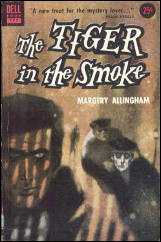
The theme of the novel was first expressed by Allingham in The Oaken Heart (M. Joseph, 1941):
Active evil is more incomprehensible in this two-part-perfect world than active good, and so it ought to be.
The novel follows Havoc’s crimes and the police hunt for him as he terrorizes the Smoke on a rampage involving his hunt for a treasure he believes is hidden in St. Odile. Eventually Havoc and Avril confront each other and Avril tries to warn Havoc that his “Science of Luck” is a false god:
“Evil be thou my Good, that is what you have discovered. It is the only sin which cannot be forgiven because when it is finished with you you are not there to forgive.”
And it is to Allingham’s credit that while Avril is wholly good, even Havoc is not wholly evil. In the end he is destroyed as much by that touch of good he cannot avoid as by all his evil actions and plans.
It isn’t as if Campion has nothing to do in the novel. In fact he has one Great Detective moment, and a memorable one as it turns out, because during it Lugg gets to express the frustration of every Watson in the genre and no small number of readers.
Campion and Amanda are in their car with Lugg driving, and in response to a question from Amanda Campion gives one of those obscure Great Detective answers where he doesn’t quite answer the question about a written clue and Lugg explodes:
“Oh, for God’s sake! … Drivin’ this and listenin’ to you, it’s like being up to me eyes in the creek. What ’ad the perisher wrote down?”
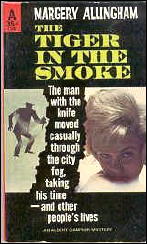
You just know that Watson, Archie Goodwin, and even Captain Hastings felt like expressing something very close to that a thousand times.
Havoc and the Canon aren’t the only characters in the book worth noting. Young Inspector Luke is new to the area and caught up in the brutal violence fired by Jack Havoc’s quest for his treasure; Geoffrey Levitt and Meg Eliginbroddie, a young war widow, are lovers caught up in the danger; Doll is a gang leader challenged and endangered by Havoc’s reckless crimes; and Mrs. Cash, Havoc’s mother is often the voice of the Smoke itself.
In the film Tony Wright was Havoc; Laurence Naismith, Canon Avril; Alec Clunes, Charlie Luke; and Bernard Miles was Doll. Sadly the film is too little seen and hard to find, but it is well worth catching if you get the chance. Roy Ward Baker’s other films include Highly Dangerous and The October Man both excellent suspense films (and both with screenplays by Eric Ambler).
The inevitability of Havoc’s fall doesn’t interfere with the suspense as the novel moves along tightening the suspense and involving the reader more deeply.
Tiger in the Smoke is one you won’t easily forget or put aside when you have finished it. Jack Havoc will linger in your imagination in a way human monsters sometimes do long after the theatrics of a Hannibal Lector have been consigned to the same sub-basement of the imagination as Bruce the Shark or other childish fears.
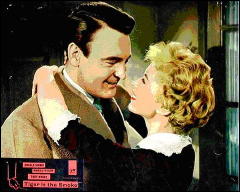
Allingham manages to capture real evil in all its attraction and repulsion just as she counters it with a good man who is neither cliched nor unworldly. For that alone this is a first class novel and not only a detective novel — though it is a good one of those too.
And it really is a remarkable novel to have been written by one of the unquestioned queens of the Golden Age of Detective Fiction.
Editorial Comment. 07-15-10. I’ve done a search for Tiger in the Smoke on DVD, and if you have a multi-region player, then you’d be in luck, if you were looking for it. I found a boxed set of Donald Sinden movies on Amazon-UK, and Tiger is one of them.
Others: DAY TO REMEMBER, YOU KNOW WHAT SAILORS ARE, THE BEACHCOMBER, MAD ABOUT MEN, ABOVE US THE WAVES, AN ALLIGATOR NAMED DAISY, EYEWITNESS, THE BLACK TENT, ROCKETS GALORE, and MIX ME A PERSON. All for less than 18 pounds.
Tue 13 Jul 2010
A REVIEW BY CURT J. EVANS:
SAPPER [H. C. McNEILE] – Knock-Out. Hodder & Stoughton, UK, hardcover, 1933. US title: Bulldog Drummond Strikes Back. Doubleday Doran/Crime Club, hardcover, 1933. Reprints: Grosset & Dunlap, hc, 1934; Triangle, hc, 1943; House of Stratus, UK, trade paperback, 2001.
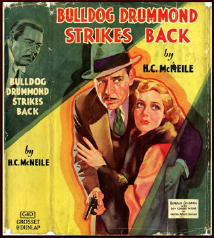
Films: United Artists, 1934, as Bulldog Drummond Strikes Back (Ronald Colman, Loretta Young; director: Roy del Ruth). Also: Columbia, 1947, again as Bulldog Drummond Strikes Back (Ron Randell, Gloria Henry; director: Frank McDonald).
English thriller writer Sapper (pen name of Herman Cyril McNeile) is a much maligned figure of late decades, his famous hero Captain Hugh “Bulldog” Drummond now being seen as less a “clubland hero” than an arch-conservative, racist, public-schooled bully.
This perception is fueled especially by offensive racial comments made by Captain Drummond in some of the 1920s novels, like The Black Gang (1922) and The Female of the Species (1928). Eric Ambler represented the views of many in dismissing Sapper’s books as essentially fascist.
By 1933, however, Hitler was consolidating his power in Germany and shocking much of the civilized world with his bellicose, frequently anti-Semitic, rhetoric and behavior. Sapper continued publishing thrillers up until his premature death in 1937. What was the tenor of his later works?
My conclusion from reading Knock-Out (1933) is that if you are offended by it, you are pretty easily offended.
Knock-Out opens with Ronald Standish (familiar to Sapper readers from the Sherlock Holmes inspired pastiches he appeared in throughout the 1930s — they should have been collected under the title Knock-Off) and his friend Bill in Ronald’s flat discussing a vital matter — golf — when a phone call from Ronald’s friend Sanderson comes through asking Ronald to come over to his place immediately.
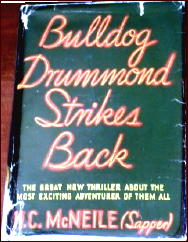
But the line goes dead! Ronald and Bill head over to Sanderson’s place, only to discover Sanderson dead, stabbed — or shot? — through the eye.
They then encounter Hugh Drummond and his friend Peter. The mighty Hugh is about to pound Ronald and Bill into the floor when Peter stops him with an important piece of information: “It’s Ronald Standish. I’ve played cricket with him.”
Ronald’s bona fides as a sportsman established, the four good fellows are able to come together on a plan over what to do about Sanderson’s murder. It seems that Sanderson was on the trail of some sort of BIG criminal conspiracy.
Of course, letting the police or intelligence service in on the “show” in any big way is unthinkable — this is a job for impetuous, sporting, public-schooled amateurs!
Soon Hugh, Ronald and pals are on the hunt for the conspirators, who include a noted society doctor, a sadistic American film actress and, worst of all, a cross-dressing, bald-headed Greek man with lacquered fingernails.
A number of elements from earlier tales are recycled. Hugh again indulges his odd penchant for disguise, his Wodehouseian pal Algy is made to take notes of Hugh’s deep thoughts (to what purpose is not evident), there is a loyal “old nurse” of one of the the fellahs on hand when needed and, of course, a pretty, plucky nice girl (Daphne Frensham — “an absolute fizzer”) shows up to help out the lads, as well as to engage in some light romantic banter with Peter (Hugh’s wife presumably is out shopping during this one).
The heroes’ headstrong assault on the villains’ country house headquarters also will seem familiar, as will the fact that it is defended by a fearsome beast (here, a mastiff “the size of a donkey” — young apes were not available this season, evidently).
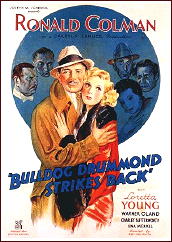
Hugh also goes into one of his patented berserk rages, splitting open one filthy swine’s head and throwing another off a railway embankment, but they really were rather rotters, I will stipulate (they had committed an act of what we would call terrorism today and were in the process of attempting another one).
Yet not all is pure action. The presence of the relatively cerebral Ronald Standish gives Sapper an excuse to indulge a little in the exercise of a bit of brain power. There is much speculation over exactly how Sanderson was killed and there is a cipher that plays a major role in the tale.
However, during the course of the action Standish is drugged, kidnapped, kidnapped yet again and concussed by a bomb, so let us just say that his brains are not always fully operational throughout the tale.
Perhaps most interestingly, Sapper takes time to present, in a quite sympathetic manner, a Jewish shopkeeper named Samuel Aaronstein, alone with his wife and son. If Knock-Out ever was reprinted in Nazi Germany — and we know Hitler liked Edgar Wallace thrillers — this section of the book would not have found favor.
It should be noted as well that the sadistic American film actress who is aroused by seeing men being tortured to death is not exactly a cozy concoction. I could never quite figure out why she was necessary to the success of the conspiracy, but she certainly added a frisson of wicked decadence.
So, while Knock-Out is not perhaps the most original of Sapper’s thrillers, it is as smoothly competent as any of the author’s books, and it is not as offensive as people will tell you Sapper works invariably are.
Sure, the lower class characters all speak exaggerated cockney-ish dialect, the street boy with the message for our heroes is invariably referred to by them as “the urchin” (I was half expecting “ragamuffin”) and the head villain is a creepy hermaphrodite (or something like). But, honestly, you must have read more obnoxious books than this one from the period.
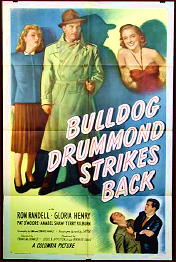
I suspect part of the animus against Sapper has to do with the fact that the academics who write much of the mystery criticism today are precisely the eggheads who would have been made to eat dirt three times a day in public school by a young Bulldog (and don’t we know it). Though, admittedly, I too find some of the earlier books distasteful in parts.
Interestingly, Sapper’s father, Captain Malcolm McNeile (1843-1901), was a naval officer and prison warden described as “a ‘rod-of-iron’ officer from the old school” and “a disciplinarian of the meanest type.” And Sapper’s paternal grandfather, Reverend Hugh McNeile (1795-1879) [FOOTNOTE], was an evangelical Anglican minister considered “unquestionably the greatest preacher and speaker in the Church of England” in the nineteenth century.
With this background, it’s probably no wonder that the Sapper books are as conservative (and sometimes bullying) as they are. Whether they are “fascist” — with all that that ideology entails — is to my mind open to question, however.
Conservative and fascist are not synonymous terms. Sapper’s clubland heroes may be vigilantes doing what they do “for the good of England” (which usually seems to mean people earning income off invested capital), but they often seem to find it unnecessary to inform the State what they are doing.
Fascist dictators might have found them a little too anarchic and individualistic in that respect.
FOOTNOTE: Reverend Hugh McNeile obtained his first living in 1822 from the wealthy banker and politician Henry Drummond. Put those names together and I think that we surely have the inspiration for the name of Sapper’s greatest hero.
Previously reviewed on this blog:
The Black Gang (by David L. Vineyard)
Bulldog Drummond (by Steve Lewis)
Tue 13 Jul 2010
Posted by Steve under
Reviews[10] Comments
DANIEL BOYD – ’Nada. Casperian Books, trade paperback, 2010.
I have a semi-formal, strictly unwritten and not always enforced policy against reviewing books written by authors I know personally. But that shouldn’t stop me from telling you about them, now should it? No, I didn’t think so.

Case in point. ’Nada has yet to be published – I believe it’s scheduled for some time early this fall – and when it is, I’ll tell you about it again. The author’s name on the title page is Daniel Boyd, but that’s a pen name of one of the regular contributors to this blog’s pages. (Whispering so no one else can hear: Dan Stumpf.)
I don’t think he’ll mind my telling you that, but if it’s a secret, I’ll delete that last previous sentence and you’ll have to find out in some other fashion later on.
It’s a book that takes place in Mexico, in and around an all-but-abandoned silver mine watched over by one man, the one who tells the story, Vernon Culley, a mining engineer from Kansas City. We know that much about him that right away, but not much else. Bit by bit, though, other pieces of his background get filled in as the story goes along.
The year is 1936, right in the middle of the Great Depression, and Mexico, feeling the ailment as well as up in US, if not worse, is filled with banditos of all makes and models, which is how the story begins: with an old ambulance and the two men in it entering Culley’s small domain while fleeing a gang of ornery local outlaws headed by a fellow named Paco Serrano.
Right about now – and this is about all I’m going to tell you about the plot – you should maybe know whether this is a book for you or not. But if you’re still uncertain, let me warn you that this is not a book for most “cozy†lovers, nor should you expect a locked room mystery to suddenly pop up and take over the tale.
For a book of action, which of course is what this is in part, told by a strong authorial voice as if the teller of the tale were in the same room with you – one I could hear all the way through – I think the strongest parts were not the sections with the gunplay, which at one point is fast and furious indeed, but rather the quieter more reflective ones.
Such as when Culley and his newly found friend Ray (one of the two men in the ambulance) are making their way across the desert to a town called Quenada (hence the title, making the apostrophe important if not essential) talking about life and death and men on the borderline between the two — and promises that have been made to them.
It’s also a novel about gold, and the allure it has to men. It’s also a story told by a man who reads both Black Mask and “Hamlet,†and knows what the essentials are of each. If you were to ask me, I’d say that I think you should read it, but if you’ve read this non-review this far, you already know that, don’t you?
[UPDATE] 07-15-10. From the Casperian webpage I’ve discovered that ’Nada will be published on September 1st, and if you’d like to read the first chapter, it’s online there also.
Mon 12 Jul 2010
Posted by Steve under
GeneralNo Comments
We’ve had to install a new WordPress interface here. All seems to have gone well — no posts lost! — but if you go back a few weeks you’ll see that strange symbols have replaced some (not all) apostrophes, dashes and stray quotation marks.
I’ve edited them out of the most recent posts, I hope, but it will be a while before they disappear altogether. All part and parcel of doing business in the age of the future — constant upgrades — this time because of security concerns — but not always perfectly!
Mon 12 Jul 2010
Posted by Steve under
Reviews[6] Comments
REVIEWED BY DAN STUMPF:
DAVID GOODIS – Of Tender Sin. Gold Medal #226, paperback original; 1st printing, 1952; Gold Medal 616, 2nd printing, 1956.
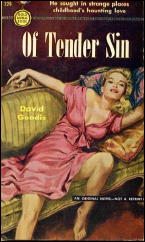
David Goodis is one of those bleak, lost figures of pulp literature, legendary now but neglected in his day, who churned out millions of words in his youth for the pulps, and in the 50s and 60s produced some unforgettable classics in paperback.
Of Tender Sin features some of Goodis’s best writing and lousiest plotting, starting for no apparent reason as hero Alan Darby, a middle-class office worker with a house and wife in the suburbs, suddenly becomes “unstuck from himself” and begins wandering the seedy streets of Philadelphia’s tenderloin in the middle of a harsh winter.
It ends for the same no-reason, apparently when Goodis got tired of writing it. But along the way, we get drugs, kinky sex, beatings, incest, robbery and murder, all put across with some of the most incredibly vivid prose I’ve ever read.
Goodis conveys Philly like Camus did Algiers in The Stranger: when he writes, you feel the cold snow seep into your boots, taste the cheap, satisfying greasy-spoon chow, feel the impact of a sudden punch, this is writing for its own sake, and to find it between the covers of a two-bit paperback is one of the delights that come only to collectors like us.
« Previous Page — Next Page »

